Autumn sage (Salvia greggii) is a gorgeous flowering perennial that deserves a spot in any garden looking to add vibrant, long-lasting color. With its abundant tubular blooms in shades of red, pink, orange, yellow and more, the autumn sage livens up borders, containers, and more throughout its lengthy flowering season.
In this comprehensive guide, you’ll discover how to successfully integrate autumn sage into your outdoor space for a stunning display
An Overview of Autumn Sage
Native to Texas and Mexico, the autumn sage is a semi-evergreen subshrub that typically reaches 2-3 feet tall and wide It’s a member of the mint family Lamiaceae.
The oval green leaves release a pleasant, aromatic fragrance, especially when crushed. But the main draw of this plant is its flowers.
Blooming from spring through fall, the tubular flowers appear in colors like:
- Fiery red
- Vibrant pink
- Brilliant orange
- Soft yellow
- Soothing lavender
Cultivars like ‘Furman’s Red’ and ‘Desert Blaze’ offer more unique flower colors to choose from.
In addition to its long season of color, there are many other reasons to love autumn sage:
- Drought tolerant once established
- Thrives in full sun and hot climates
- Attracts pollinators like hummingbirds and butterflies
- Deer and rabbit resistant
- Fragrant foliage
- Low maintenance
With proper placement and care, autumn sage will reward you with months of glowing color and visual interest. Keep reading to learn how to incorporate this stellar plant into your garden design.
Selecting the Right Location
Choosing an optimal spot for your autumn sage ensures it will thrive and enhance your landscape. Here are the ideal growing conditions to look for:
-
Full Sun: Autumn sage flourishes in a full sun location receiving at least 6 hours of direct sunlight daily. Morning sun is especially beneficial.
-
Well-Drained Soil: Excellent drainage is key, so avoid planting in soggy soil. Sandy, gravelly, or rocky soil is ideal.
-
Hot Climate: This heat-loving plant revels in the high temperatures of USDA Zones 7-9. It can struggle in cooler climates.
-
South or West Exposure: A southern or western exposure heats up nicely for this sun-worshiping plant.
Take note of areas in your outdoor space that meet these key criteria. Positioning autumn sage accordingly enables it to put on its best floral display.
Planting Autumn Sage for Success
Once you’ve chosen the perfect sunny, dry spot, it’s time to get planting!
Follow these tips for success:
-
Spring Planting: Plant autumn sage in spring after the threat of frost has passed.
-
Amend Soil: Work compost or organic matter into the soil to enrich it before planting.
-
Give It Space: Allow 2-3 feet between each plant to accommodate its spread.
-
Dig Wide Holes: Dig holes twice as wide and deep as the root ball.
-
Check Depth: Ensure the crown sits level with the soil line and avoid planting too deeply.
-
Water Well: Water thoroughly after planting.
-
Apply Mulch: Add a 2-3 inch layer of mulch around plants to retain moisture and reduce weeds. Replenish as needed.
With the right planting techniques, your autumn sage will soon take off and start showing its beautiful blooms.
Using Autumn Sage in Your Design
There are endless ways to incorporate autumn sage into garden beds, borders, containers, and landscapes. Here are some ideas to spark your creativity:
Crystallize Borders
Lining walkways, fences, or edges of beds with autumn sage creates an electrifying border. For multi-season interest, combine it with evergreen shrubs, ornamental grasses, sedums, and other perennials.
Pollinator Power
With copious nectar-rich blooms, autumn sage lures hummingbirds, butterflies, and bees. Plant en masse in borders, beds, or containers to create an enticing pollinator habitat.
Patio Pizzazz
Let autumn sage flaunt its stuff up close and personal by planting it in containers near seating areas, porches, or patios. Combine with annuals or trailing plants for added pizzazz.
Rock Garden Reign
Tuck autumn sage into that hot, dry spot in your rock garden where little else thrives. The colorful blooms will stand out beautifully amidst the rocks and elevate the entire design.
Curb Appeal Boost
Strategically situate autumn sage plants near your home’s entrance or mailbox for a striking welcome. The eye-catching hues enhance curb appeal.
Mix and Match
Blend autumn sage with grasses, sedums, daisies, zinnias, and more for a dynamic, colorful combination. Play with height, texture, and flower forms for maximum appeal.
Caring for Autumn Sage
While relatively low maintenance once established, autumn sage does benefit from some simple care practices:
-
Watering: Allow the soil to dry out between waterings. Water deeply when needed during drought.
-
Fertilizing: Apply a balanced fertilizer at planting and once in spring. Avoid high nitrogen formulas.
-
Pruning: Prune lightly in late winter to shape and improve density. Avoid heavy pruning.
-
Deadheading: Remove spent blooms to encourage more flowering.
-
Propagating: Take 3-4 inch stem cuttings in summer to propagate new plants.
-
Pests/Diseases: Watch for whiteflies, powdery mildew, and root rot. Treat promptly if issues occur.
With the proper placement, plant pairings, and care, autumn sage will bring dynamism and flower power to your garden or landscape for years to come. Let its brilliance shine through in your design!
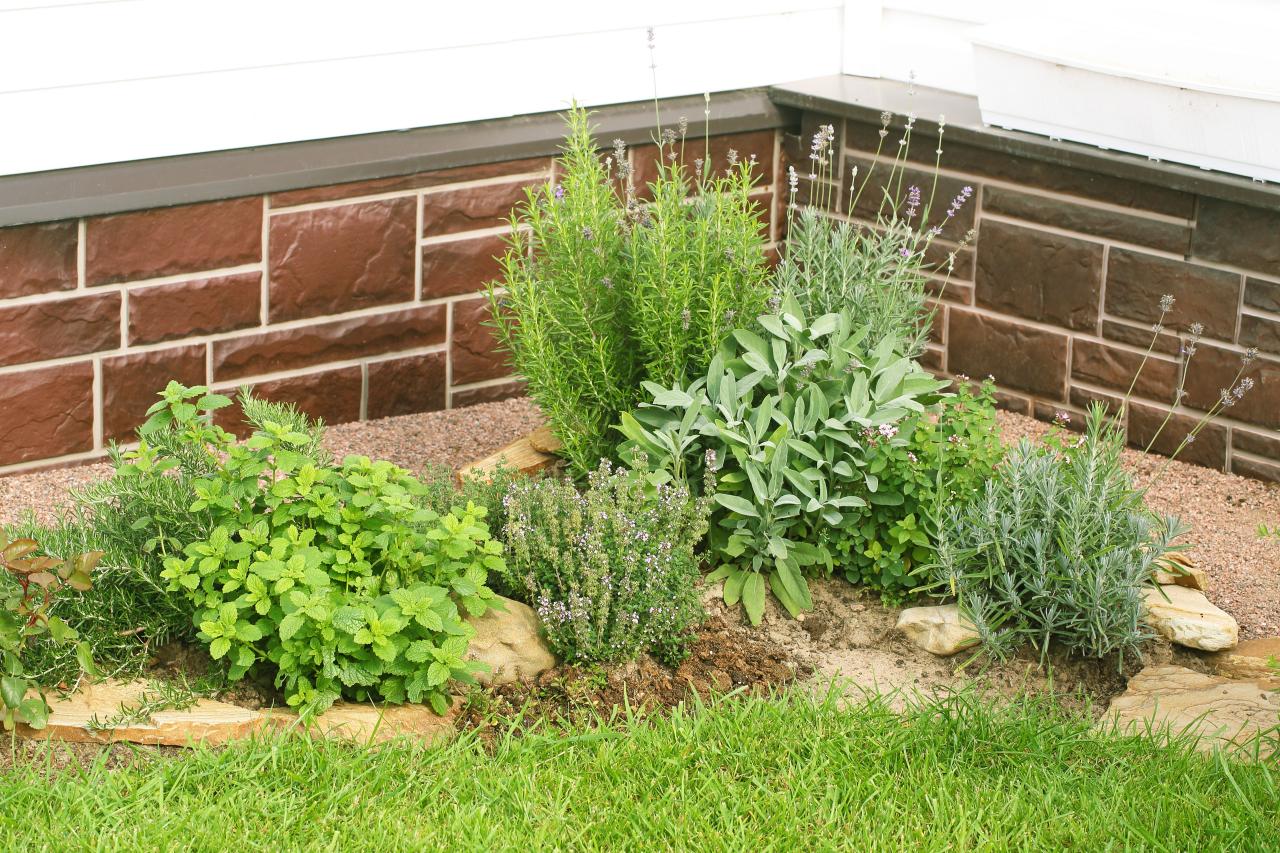
Timing Matters in Plant Pairings
I pair my bougainvillea with yellow bell shrubs. Their colors contrast nicely, and they screen out the back wall of my garden. I give them plenty of room to grow, and they produce beautiful flowers spring through fall. If you do have a swimming pool and don’t like bougainvillea, how about trying orange jubilee (Tecoma hybrid ‘Orange Jubilee’) and Texas Sage (Leucophyllum frutescens) together?
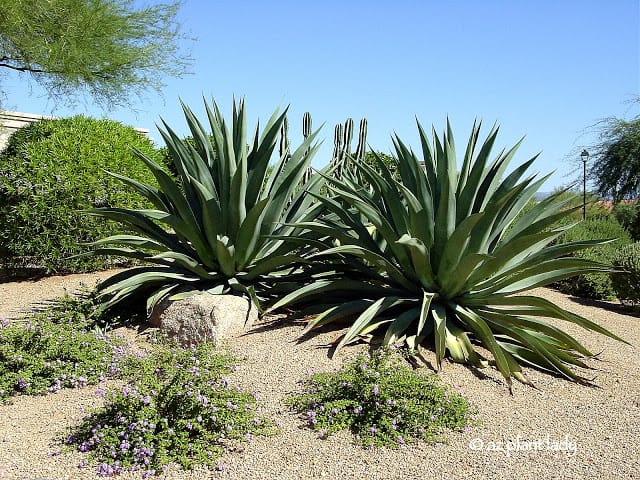
Weber’s agave (Agave weberi) and purple trailing lantana
I have just one more tip – if you want to pair flowering plants together to enjoy the contrasting colors, make sure that they bloom at the same time of year. It is so easy to visit the plant nursery and see the pretty photos of flowers on the different plants and pick what ones you think will look great together only to discover later that one flower in the fall while the other blooms in spring and so you never see their flowers at the same time.
So, visit your local nursery and try some of the suggested plant combinations or see what beautiful plant pairings you come up with for your garden.
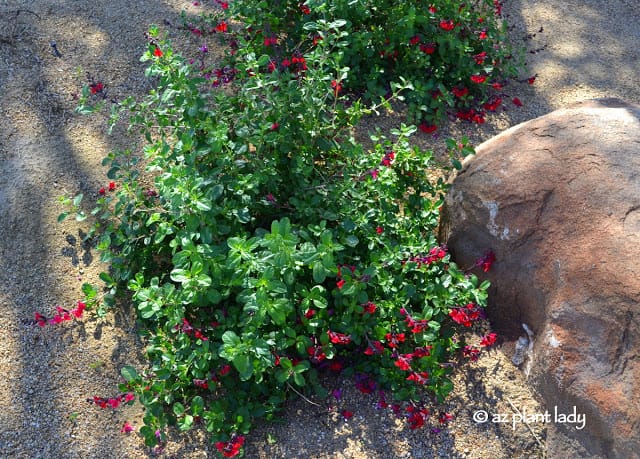
Do you like hummingbirds?
If so, you may want to make sure that you have some autumn sage (Salvia greggii) growing in your garden – it is a hummingbird magnet.
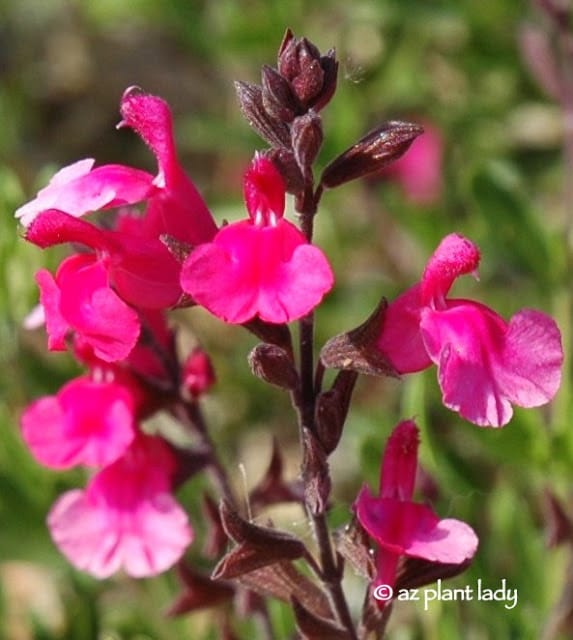
While red is the most common color of this small shrub, it also comes in other colors including shades of pink, purple, coral and white.
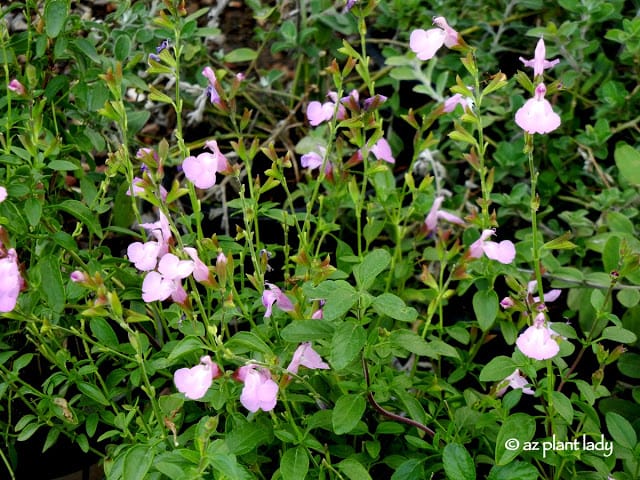
It has has a long bloom period in low desert gardens, beginning in fall and lasting until late spring. When growing in the flat desert, plant it in a filtered shade for best results. Prune back by 1/2 its size in early March.
Large Shrub Plant Combinations
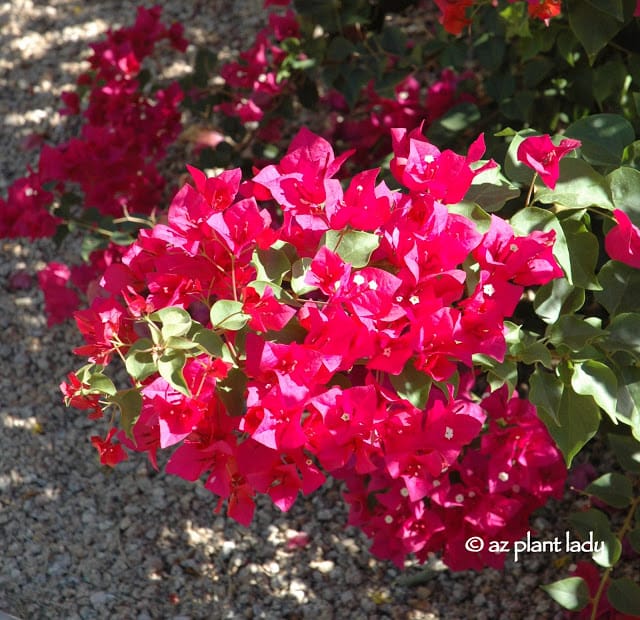
I often recommend the following for those who are looking for large shrub combinations. Okay, I realize that many people either love or hate bougainvillea. Personally, I love them. I have two bougainvillea and since I don’t have a swimming pool, so I am not bothered by their litter. Their beautiful and vibrant colors are amazing.
Plant to Know: Autumn Sage
FAQ
What to pair with Autumn Sage?
Where is the best place to plant Autumn Sage?
How far apart should I plant Autumn Sage?
Does Autumn Sage like sun or shade?
How to grow autumn sage?
Autumn Sage is a popular plant among gardeners because of its beautiful flowers and ease of care. Here are some tips on how to grow Autumn Sage: Choose the right location: Salvia greggii prefers full sun to partial shade and well-drained soil. Make sure to choose a location that gets at least 6 hours of sunlight a day.
How do you care for autumn sage?
Autumn sage is a fairly easy-going plant. Here are the main care requirements for growing autumn sage. Plant in a spot that gets lots of sunlight, ideally at least six hours. Place in dry, well-drained soil, but do not plant in wet, clay-based soil. Water moderately, though autumn sage is fairly drought-tolerant once established.
How do you plant autumn sage?
Autumn sage can survive in very lean soils, and for this reason, amending the planting site is not necessary. Dig a hole the same depth as the pot it arrived in and at least twice as wide. Place the sage into the hole and backfill with soil. Water it in well and provide regular water for the first few weeks until it has become established.
What is autumn sage?
Autumn Sage, also known by its scientific name Salvia greggii, is a beautiful and versatile plant that can add a pop of color to any garden or landscape. This plant is native to the southwestern United States and Mexico, and is well known for its vibrant flowers and aromatic foliage.
